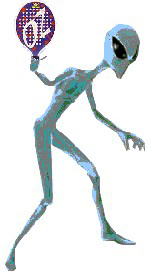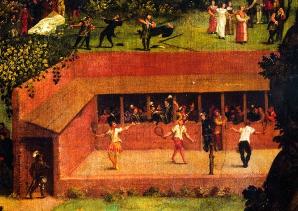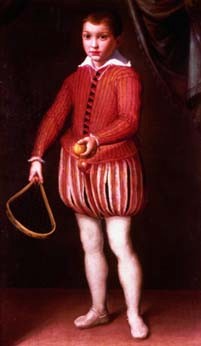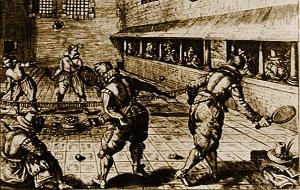Revisionist History
Cron Mueller, Springfield, Illinois
 Platform traditionally traces its origin back to Scarsdale, N.Y., and a couple of sports enthusiasts, Blanchard and Cogswell. They were thought to have developed the game as a winter alternative to tennis.
Platform traditionally traces its origin back to Scarsdale, N.Y., and a couple of sports enthusiasts, Blanchard and Cogswell. They were thought to have developed the game as a winter alternative to tennis.
The game of tennis as we know it was originally referred to as "lawn tennis," the adjective used to distinguish it from its older sibling, "court tennis," known as "jeu de paume" in France, "pallacorda" in Italy, "ballhaus" in Germany, and "kaatsbaan" in the Netherlands. Court tennis traces its roots back at least five of centuries, and claims of being "first" are made by Italy, the Netherlands, and France. The oldest extant court is at Fountainebleu near Paris, dating back to 1605. Generally it is suggested that the court tennis that became popular in several countries within a fairly short period of time was introduced by travelling minstrels, which would account for its rapid dissemination. Beyond that, the earlier ancestors of tennis are difficult to trace. root, and indeed the long handles and web-like head on the sticks bear a certain resemblance to early tennis rackets. Others would point to Graeco-Roman versions of handball as the most ancient of ancestors. Some have suggested that primitive man began it all by learning to hit rocks with clubs or sticks to volley them over earthen and rock walls, though no evidence of this being done for mere sport exists. And of course badminton would have to enter in to any discussion of the roots of modern tennis. The similarities between these sports are too striking to ignore, suggesting perhaps a common origin for all of them.
 |
| Image from the Towel of Scarsdale |
Have you ever happened upon a platform court in the woods at night, with its lights on and a game in progress? The first sensation is of the unearthly glow through the trees in a previously unknown clearing. As you get closer, the light becomes brighter, almost unbearable. And then there are strange sounds from the light source, low thumping and shuffling noises. If by chance your eyes can adapt to the light, what is observed is a raised structure, seemingly hovering above the ground, with some sort of enclosure around it. Within the enclosure are oddly clad creatures wielding strange instruments striking a phosphorescent yellow orb back and forth. At least one of the creatures is wearing what we might now describe as wrap-around eyewear(probably Bolle's).
What modern human beings would tell their friends is that they came upon a strange new game, called platform tennis, being played by a bunch of weirdos out in the middle of nowhere in the dead of winter. But what would prerational, prelogical humans have said about this experience of platform, not as "It" but as "Thou?" And having observed the game of platform being played, how successful would they have been in trying to recreate the game and play it? Without the benefit of modern materials, what would premodern human beings have constructed their "paddles" out of? Likely, of wood strung with animal guts, to simulate the perforated surface observed.
And so it was thousands of years ago when aliens first landed on earth, and were first observed through the trees by prehistoric humans, where they had landed their vessel topped with a platform court in order to play a few sets. What could have prepared these mythopoeic hunters for such a sight? Needless to say they viewed these aliens as gods, and naturally sought to imitate the activity they observed.
 |
| Image from the Towel of Scarsdale |
Platform scientists postulate that the combination of heat from the spacecraft below the court (kept running to keep ice from forming on the playing surface), light from the halogen fixtures, and a flash from a falling meteor (likely causing the end of the younger dryas) imposed the photographic negative on a towel draped over the netpost.
Recognizing that some skeptics will dispute the authenticity of the Towel's photographic evidence, a few images of early court tennis will better explain the plausibility of the original earthly courts being an effort to recreate their other worldly progenitors, courts on top of spaceships.
Tennis as one of the Chivalrous Exercises. Italian Painting (Anonymous, 1570/80).
Photo from Dutch Real Tennis Association website
The painting depicts an enclosed court, raised off the ground, with spectators viewing play over a side wall that strangely resembles snow boards. Contemporaneous accounts of the game suggest that like modern "real tennis," the ball was played off the walls.
 |
| Italian Boy with Racket. Master Painting (Cremona, 1570). |
Further photographic proof comes in the form a a painting of an early "real tennis" player
Can anyone deny the remarkable similarity between this early player's garb and the plaid slacks worn by Dave Jennings and Bob Kingsbury back in the sixties and seventies? Some have even noted a striking resemblance between this early player and the youthful photos of Dave Ohlmuller sent in to the platform newsletter by his mother.
Another photograph of court tennis helps point to its ancestry.
As with the painting above, doubles is the game, the ball is played off the walls, and various articles of clothing can be seen at court edge, reflecting that layering of clothes was a fact of life just as in platform sought to be imitated.
Skeptics might question the lack of any evidence of platform between the date of the Towel of Scarsdale and the meteoric rise of court tennis in the late middle ages. This can be explained by the geological record. Geologists and palynologists place the end of the younger dryas at approximately 10,000 years ago, which would correspond roughly with the radiocarbon dating of the Towel. Palynological data also points to a "little ice age" approximately 600 years ago, which would correspond to the rise of court tennis. Clearly, with the climate warming between those dates, the aliens had to play paddle further north, away from populous areas. As global temperatures dropped 600 years ago, as evidenced by the frozen canals, etc., depicted in the Hans Brinker stories, they played nearer populous areas, and were likely observed outside of towns by the very travelling minstrels who introduced the game to the courts of kings.
 |
| Students of Leyden University playing tennis (1610) |
Some scholars would point to a "third contact" between humans and alien platform players, occuring in the late 1800's when Reverend Beal happened upon an alien game in progress in the woods near his home, but no firm evidence has been found to confirm this. Others would suggest that Blanchard and Cogswell themselves stumbled across a game in progress near Scarsdale, but were too embarassed to relate the true inspiration for their new game, but with no other confirmed reports of alien sightings around that time in New York, most dismiss this theory.
What is clear is that the platform that developed through Cogswell and Blanchard took 10,000 from its initial viewing by human beings to evolve into its end form. All that remains is for Dick Reilly to mount the courts on hovering craft, to speed their installation and increase their mobility, for platform to have reached finally its evolutionary end - and beginning.







